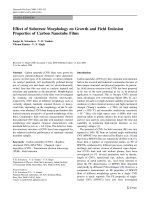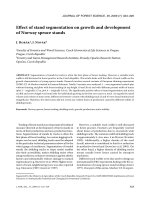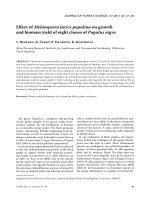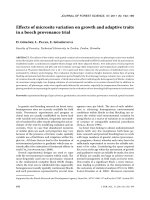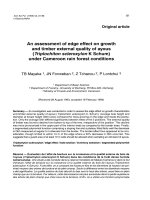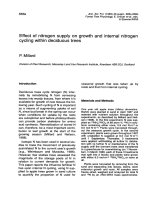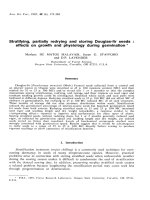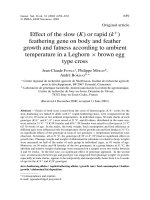effects of culture conditions on growth and feather degradation capability of bacillus pumilus k8
Bạn đang xem bản rút gọn của tài liệu. Xem và tải ngay bản đầy đủ của tài liệu tại đây (631 KB, 23 trang )
MINISTRY OF EDUCATION & TRAINING
CAN THO UNIVERSITY
BIOTECHNOLOGY RESEARCH & DEVELOPMENT INSTITUTE
SUMMARY
BACHELOR OF SCIENCE THESIS
THE ADVANCED PROGRAM IN BIOTECHNOLOGY
EFFECTS OF CULTURE CONDITIONS ON
GROWTH AND FEATHER DEGRADATION
CAPABILITY OF BACILLUS PUMILUS K8
SUPERVISOR
STUDENT
Dr. BUI THI MINH DIEU
TRAN LE BACH
Student’s code: 3083473
Session: 34 (2008- 2013)
Can Tho, 5/2013
APPROVAL
SUPERVISOR
Dr. BUI THI MINH DIEU
STUDENT
TRAN LE BACH
Can Tho, May , 2013
PRESIDENT OF EXAMINATION COMMITTEE
Abstract
An inducible keratinase is produced by Bacillus pumilus K8 in
a feather medium. Under submerged fermentation condition with
continuous agitation (180 rpm), high level of keratinase production
occurred at 40oC after 120 h at pH 6.0.Cornstarch supported the
highest level of keratinolytic production at 2% concentration
compare to other carbon sources. 0.5% ammonium chlorite was a
good concentration of nitrogen source for the production of
keratinolytic activity and feather degradation by Bacillus pumilus
K8. Present results indicate that Bacillus pumilus K8 can be a
highly useful organism for feather meal production as animal feed
staffs, biofertilizer and in leather industry.
Keywords: Bacillus pumilus, feather degradation, feather
meal, keratin, keratinase
i
CONTENTS
ABSTRACT………………………………………………...........i
CONTENTS..………………………..……………...……....…...ii
Abstract .......................................................................................... i
1.
INTRODUCTION ................................................................. 1
2. MATERIALS AND METHODS .............................................. 3
2.1. Materials ............................................................................. 3
2.2. Methods .............................................................................. 4
2.2.1. Method for testing enzyme activities .......................... 4
2.2.2. Method for determinating of bacterial growth and
feather degradation ...................................................... 4
2.2.3. Effect of medium pH and cultural temperature on
growth and feather degradation by Bacillus pumilus
K8 ................................................................................ 5
2.2.4. Effect of different carbon sources on growth and
feather degradation by Bacillus pumilus K8 ............... 6
2.2.5. Effect of different nitrogen sources on growth and
feather degradation by Bacillus pumilus K8 ............... 6
2.2.6. Effect of feather concentrations on growth and feather
degradation by Bacillus pumilus K8 ........................... 7
2.2.7. Effect of time course on growth and feather
degradation by Bacillus pumilus K8 ........................... 7
3. RESULTS AND DISCUSSION ............................................... 9
3.1. Effect of medium pH and cultural temperature on growth
and feather degradation by Bacillus pumilus K8 ............... 9
ii
3.2 Effect of different carbon sources on growth and feather
degradation by Bacillus pumilus K8 ................................ 10
3.3 Effect of different nitrogen sources on growth and feather
degradation by Bacillus pumilus K8 ................................ 11
3.4 Effect of feather concentrations on growth and feather
degradation by Bacillus pumilus K8 ................................ 12
3.5 Effect of time course on growth and feather degradation by
Bacillus pumilus K8. ........................................................ 13
4. CONCLUSIONS AND SUGGESTIONS ............................... 15
4.1. Conclusions ...................................................................... 16
4.2. Suggestions ...................................................................... 16
REFERENCES ............................................................................ 17
iii
1.
INTRODUCTION
Feathers represent 5-7% (w/w) of the total weight of mature
chickens and are generated in large amounts as a waste product in
commercial poultry-processing plants, reaching millions of tons
per year worldwide. Poultry feathers were discharged into the
environment
after
the
processing
which
leads
to
the
environmental pollution. Discarded feathers cause various
human ailments including chlorosis, mycoplasmosis and fowl
cholera. Although the feathers are considered as wastages, it
contains large amount of protein and this protein can be
converted into animal feedstuffs which helps to reduce the
protein shortage and cost effects. Poultry feed production plays
an important role in protein supply and in agricultural economy.
The protein shortage for food and feed leads us to look for a
new protein sources from wastage products like feather wastes.
Feathers are a significant source of protein for livestock because
of their high protein content (>85% CP). Feathers contain large
amounts of cysteine, glycine, arginine and phenylalanine. Raw
feathers, however, are very poorly digested by non-ruminant
animals because they contain a high proportion of keratin protein
that has cysteine disulfide bonds. The indigestible structure of
raw feather must be hydrolyzed to be used as a feed
ingredient for non-ruminant species. Though keratin can be
completely dissolved by reducing agents like copper sulphate,
mercapto acetate, iodoacetic acid, amino, sodium sulphite,
1
sodium tetrathionate these methods are not suitable for the large
scale application. In order to overcome these limitations the use
of microbial enzymes which improves the nutritional value of
feather wastes have been implemented in recent years.
Keratinase enzyme are among the most important industrial
enzymes; they are primarily employed as detergent additives,
accounting for 40-60% of the global enzyme market. Alkaline
proteases are group of proteolytic enzymes that are able to
hydrolyze insoluble hard proteins more effectively than other
proteases such as trypsin, pepsin and papain. The genus Bacillus
provides most of the keratinase enzyme with commercial value,
offering the advantages of being easy to culture and maintain
and they are potentially valuable in the bioconversion of
keratinous wastes; in the detergent, fertilizer, biopolymer,
pharmaceutical and animal feed industries; and in leather
processing and hydrolysis of prion proteins as well.
Therefore, such microorganisms and enzymes have been the
focus in several studies and Bacillus alkaline proteases are
reported to be among the most efficient keratin degraders.
Against these backdrops, this study aim to optimize the
culture conditions for growth and feather degradation by Bacillus
pumilus K8.
2
2. MATERIALS AND METHODS
2.1. Materials
Microorganism
Bacillus pumilus K8 was collected from Molecular Biology
Laboratory, Biotechnology Research & Development Institute,
Can Tho University.
Production of seed culture
A single colony from a freshly subcultured nutrient agar plate
was transferred into 250-ml conical flask containing 50 ml of
nutrient broth. The flask was incubated for 6-10 h at 37°C and 200
rpm in an orbital shaker until it reached to an absorbance of 0.5-0.8
at 600 nm.
Fermentation and separation of culture filtrates
The seed culture (5 ml) was transferred to 95 ml of feather mill
medium in a 500-ml Erlenmeyer flask. Feather mill medium
contained 0.075% NaCl, 0.21% K2HPO4, 0.105% KH2PO4, 0.015%
MgCl2.6H2O, 0.009% CaCl2, 0.15% molasses and 0.75% feather
mill (initial pH 7.5). The inoculated flasks were placed in a
thermostated orbital shaker for 48 h, at 37°C and 150 rpm. Samples
were withdrawn at regular intervals and centrifuged at 5,000 rpm
for 20 min. The cell free supernatant was preserved at 4°C and
used for enzyme assay and protein estimation (in duplicate).
Chemicals and equipments in Molecular Biology Laboratory.
3
2.2. Methods
2.2.1. Method for testing keratinolytic activity
This procedure tested the keratinolytic activity of keratinase
on azokeratin to begin the process, 5 mg of azokeratin was added
to a 1.5ml centrifuge tube along with 0.8ml of 50 mM potassium
phosphate buffer, pH 7.5. This mixture was agitated until the
azokeratin was completely suspended. A 0.2ml aliquot of
supernatant of crude enzyme was added to the azokeratin, mixed
and incubated for 15 min at 50°C with shaking. The reaction was
terminated by adding 0.2 ml of 10% trichloroacetic acid (TCA).
The reaction mixture was filtered and analyzed for activity (Burtt
and Ichida, 1999).
The absorbance of the filtrate was measured at 450nm with a
UV-160 spectrophotometer (LaboMed.Inc). A control sample was
prepared by adding the TCA to a reaction mixture before the
addition of enzyme solution. A unit of keratinase activity was
defined as a 0.01 unit increase in the absorbance at 450 nm as
compared to the control after 15 min of reaction (Burtt and Ichida,
1999).
2.2.2. Method for determinating of bacterial growth and
feather degradation
Bacterial growth was determined by total plate count on
nutrient agar. Feather in cultures was harvested by filtration with
the filter paper, washed twice with distilled water and dried at
80°C to constant weight. The percentage of feather degradation
4
was calculated from the differences in residual feather dry weight
between a control (feather without bacterial inoculation) and
treated sample.
2.2.3. Effect of medium pH and cultural temperature on
growth and feather degradation of Bacillus pumilus K8
To investigate the optimum assay pH and temperature on
growth and feather degradation capability of Bacillus pumilus K8.
This activity were carried out at different pH levels (4.0, 5.0,
6.0, 7.0, and 8.0) and different temperature levels (20, 30, 37, 40,
and 45ºC). The treatments were designed randomly with repeat 3
times.
Procedure: Weigh 0.5g feather meal that was washed and
dried. Add the feather meal into each of 250-ml Erlenmeyer
flasks containing 50ml of salts medium. The pH was adjusted as
experimental design. They were sterilized at 121°C in 20 minutes.
Inoculate 1ml of Bacillus pumilus K8 suspension (108
cells/ml) grown in nutrient broth at 30°C for 48h into Erlenmeyer
flasks which was sterilized before.
Cultivations were performed at 150 rpm for 7 days in a rotary
shaker with the different temperature levels as experimental
layout.
Record the bacterial density, the feather degradation and the
keratinase activity. Compare the results and then select the
optimal medium pH and cultural temperature.
5
2.2.4. Effect of different carbon sources on growth and
feather degradation of Bacillus pumilus K8
This activity investigated the effect of carbon sources on
growth and feather degradation capability of Bacillus pumilus K8.
Different carbon source like glucose, cornstarch and molasses
were added at different concentrations (1%, 2% and 3% w/v).
This activity was carried out with triplicate.
Procedure: performed similar to activity 2.2.3. Incubate flasks
at a suitable pH and temperature finding from results of activity
2.2.2. Add carbon concentrations as experimental design.
Record the bacterial density, the feather degradation and the
keratinase activity. Compare the results and then select
appropriate carbon source and carbon concentration.
2.2.5. Effect of different nitrogen sources on growth and
feather degradation of Bacillus pumilus K8
In order to find out a suitable nitrogen source on growth and
feather degradation capability of Bacillus pumilus K8, the
following different nitrogen sources such as yeast extract, soy
flour, soybean residue, NH4Cl at different concentrations (0.1%,
0.5%, 1% w/v) were amended in the medium. This activity was
carried out with triplicate.
Procedure: performed similar to activity 2.2.3. Incubate flasks
at a suitable pH, temperature and carbon source finding from
results of the previous activities. Add nitrogen concentrations as
experimental design.
6
Record the bacterial density, the feather degradation and the
keratinase activity. Compare the results and then select
appropriate nitrogen source and nitrogen concentration.
2.2.6. Effect of feather concentrations on growth and
feather degradation of Bacillus pumilus K8
This activity examined the growth and feather degradation
capability
of
Bacillus
pumilus
K8
at
different
feather
concentration (0.5%, 1%, 1.5%, 2%, 2.5%, 3% w/v). This activity
was carried out with triplicate.
Procedure: performed similar to activity 2.2.3. Incubate flasks
at a suitable pH, temperature, carbon source and nitrogen source
finding from results of the previous activities. Add feather
concentrations as experimental design.
Record the bacterial density, the feather degradation and the
keratinase activity. Compare the results and then select
appropriate feather concentration.
2.2.7. Effect of time course on growth and feather
degradation of Bacillus pumilus K8
This activity examined the growth and feather degradation
capability of Bacillus pumilus K8 on time course.
This experiment was studied at different levels (day 1, day 2,
day 3, day 4, day 5, day 6, day 7). This activity was carried out
with triplicate.
Procedure: performed similar to activity 2.2.3. Incubate flasks
at a suitable pH, temperature, carbon source, nitrogen source and
7
feather concentration finding from results of the previous
activities. Add substrate concentrations as experimental design.
Record the bacterial density, the feather degradation and the
keratinase activity with. Compare the results and then select
appropriate culture time.
8
3. RESULTS AND DISCUSSION
3.1. Effect of medium pH and cultural temperature on
growth and feather degradation of Bacillus pumilus K8
The effects of pH and temperature on keratinase activity
were determined using azokeratin as substrate. The optimal
temperatures of keratinolytic activity from other Bacillus were
between 30 and 40oC. According to figure 1 and the result of
statistical table (Table 2, Appendix 2.1) shown that the interaction
of pH and temperature effects on keratinolytic activity of Bacillus
pumilus K8. In particular, the activity of keratinase reached the
highest value at 40oC, and also has the degradation of feather at
highest value (38.04%) was described in Table 6 (Appendix 2.1).
In fact, it was demonstrated that if the temperature in the medium
was too high may cause substrate inhibition or repression of
keratinase production, resulting in a low percentage of feather
degradation. The result are in line with those reported by Daniel J
et al. (2008) using the strain Bacillus pumilus A1.
9
Figure 5: Extent of feather degradation of B.pumilus K8
The effects of initial pH of feather medium on feather
degradation are shown in Fig.5. The highest feather degradation
in B.pumilus K8 was obtainted with a starting pH of 6.0 at the
temperature is 40oC. A different result is reported in
B.lincheniformis strain K-508 by A.Ganesh Kumar et al,. (2006).
3.2 Effect of different carbon sources on growth and
feather degradation of Bacillus pumilus K8
Of all the tested carbon sources that add to culture medium
(Fig.6) cornstarch supported the highest level of production for
Bacillus pumilus K8. The activities of respiratory enzymes in
cells grown on different carbon sources explained the differences
of the oxidative ability of cells grown acrobically on glucose.
Figure 6: Effect of carbon sources on growth and feather
degradation of B.pumilus K8
Fig. 6 shows that the concentrations of support the highest
production of keratinase by Bacillus pumilus K8. Futher, increase
10
of the concentration cause gradual decrease in the keratinase
production.
3.3 Effect of different nitrogen sources on growth and
feather degradation of Bacillus pumilus K8
Ammonium chloride was a good nitrogen source for the
production of keratinase by Bacillus pumilus K8, in the medium
supplemented with 2% cornstarch (Fig.). None of the tested
inorganic nitrogen salts supported the production of keratinase by
Bacillus pumilus K8. Delection of the organic nitrogen source
was more preferable as medium protein concenentration was
increased. In the most microorganisms, both inorganic and
organic forms of nitrogen are metabolized to produce amino
acids, nucleic acids, proteins and cell wall components
Figure 7: Effect of nitrogen sources on keratinolytic
activity and feather degradation of B.pumilus K8
11
Fig.6 shows that of ammonium chloride was the best
concentration for optimal keratinase production by Bacillus
pumilus
K8.
Further
increase
of
ammonium
chloride
concentration resulted in a proportional decrease of keratinase
production.
3.4 Effect of feather concentrations on growth and feather
degradation of Bacillus pumilus K8
The microorganism Bacillus pumilus K8 was grown in
mineral medium containing different amounts of raw feathers as
the sole carbon and nitrogen source. The strain exhibited the
highest enzyme production () in culture medium containing 1.5%
of feather concentration.
Figure 8: Effect of feather concentration on keratinolytic
activity, microorganism population and feather degradation
of B.pumilus K8
12
The highest levels of feather degradation were also obtained
in the medium containing 1.5% of feathers. However, at lower or
higher feather concentrations, keratinolytic activity, feather
degradation and microorganisms population were reduce. In fact,
it was demonstrated that high feather concentration may cause
substrate inhibition or repression of keratinase production,
resulting in a low percentage of feather degradation. On the other
hand, high feather concentration increased medium viscosity
which possibly resulting in oxygen limitation for bacterial
growth. Although the substrate concentration at 1.5% bacterial
biomass does not increase sharply as the concentration of 1%, but
for the purpose of receiving the high activity of keratinase
enzyme that 1.5% feather concentration were chosen for culturing
bacteria.
3.5 Effect of time course on growth and feather
degradation of Bacillus pumilus K8.
Time course from 1 to 7 days was followed in shaking and
static incubated flasks containing the optimized of Bacillus
pumilus K8 (Fig.). Maximum keratinolytic activity was reached
after 5 days shaking incubation period for Bacillus pumilus K8. It
seems to be stable on the 4th and 5th days of the static incubation
period having maximum enzyme production on the 5th. A gradual
decrease in activity was noticed after 5th day incubation was
recorded at 22.9 (U/ml). From the 5th after, the enzyme activity
began to decrease due to keratinolytic activity is ending and the
nutrients from the medium began to deplete. The study of
13
Teodoro và Martins (2000) and Riaz (2009) have also same
result. Thus, from the results of this experiment, the incubation
period for Bacillus pumilus K8 to have the optimal keratinolytic
activity is 120 hours.
14
Figure 9: Effect of time course on keratinolytic activity, micro
organism population and feather degradation of B.pumilus
K8
15
4. CONCLUSIONS AND SUGGESTIONS
4.1. Conclusions
The elements of cultured medium as temperature, pH of
medium, carbon source, nitrogen source, feather concentration,
time showed effect on feather degradation capacity and keratinase
synthesis enzyme of Bacillus pumilus K8.
The optimal conditions of cultured medium for Bacillus
pumilus K8 to keratinase synthesis enzyme is: temperature 40°C,
pH 6.0, 2% cornstarch concentration (w/v), 0.5% NH4Cl (w/v),
1.5% keratin (w/v) and time course for culturing should be 5
days.
4.2. Suggestions
Studying the effect of the entire cultural conditions to the
biosynthesis keratinase capability by Bacillus pumilus K8.
Continuing study the processes to develop the optimal
conditions for production to achieve economic efficiency and
usability.
16
REFERENCES
Vietnamese
Cao Ngọc Điệp và Nguyễn Hữu Hiệp. 2008. Giáo trình thực hành Vi
sinh vật học đại cương. Viện NC & PT Công Nghệ Sinh Học,
Trường Đại Học Cần Thơ.
Dương Thị Hương Giang. 2008. Giáo trình thực tập Protein và Enzyme
học. Viện NC & PT Công Nghệ Sinh Học, Trường Đại Học Cần
Thơ: Trang 11-14.
Trần Đình Toại và Trần Thị Hồng. 2007. Tương lai ứng dụng Enzyme
trong xử phế thải. Tạp chí Khoa học Đại học Quốc gia Hà Nội,
Khoa học Tự nhiên và Công nghệ 23. 75-85.
English
Bo Xu, Qiaofang Zhong, Xianghua Tang, Yunjuan Yang and Zunxi
Huang. 2009. Isolation and characterization of a new keratinolytic
bacterium that exhibits significant feather-degrading capability.
African Journal of Biotechnology Vol. 8 (18), pp. 4590-4596
Kim, J.M., W.J.Lim, H.J. Suh. 2001. Feather-degrading Bacillus species
from poultry waste. Process Biochem., 37:287-291.Kreplak L,
Doucet J, Dumas P, Briki F. 2004. New aspects of the α-helix to
β-sheet transition in stretched hard α-keratin fibers. Biophys J
87:640–647
Papadopoulos MC. 1986. The effect of enzymatic treatment on amino
acid content and nitrogen characteristics of feather meal. Anim
Feed Sci Technol, 16:151–156
17
Riffel, A. and A. Brandelli, 2006. Keratinolytic bacteria isolated from
feather waste. Brazilian Journal of Microbiology, ISSN 15178382.
Rozs M, Mancziger L, Vagvolgyi C & Kevei F, Secrection of a trypsinlike thiol protease from by a new keratiolytic strain of Bacillus
lichenformis, FEMS Microbiol Lett, 205 (2001) 221-224.
Sangali, S, and A. Brandell, 1999. Isolation and characterization of a
novel feather-degrading bacterial strain. Humana Press Inc, 02732289/00/87/0017
Shih JCH, 1993. Recent development in poultry waste digestion and
feather utilization-a review. Poultry Sci, 72:1617–1620
Vidal L, Christen P & Coello M N, Feather degradation by Kocuria
rosea in submerged culture, World J Microbiol Biotechnol, 16
(2000) 551-554.
Williams, C.M, C.S. Richter, J.M. Mackenzie and J.C.H. Shih,
1990. Isolation, identification and characterization of a
feather degrading bacterium. Appl. Environ. Microbiol.,
56: 1509-1515.
Webpage
(November 20th, 2011)
18
